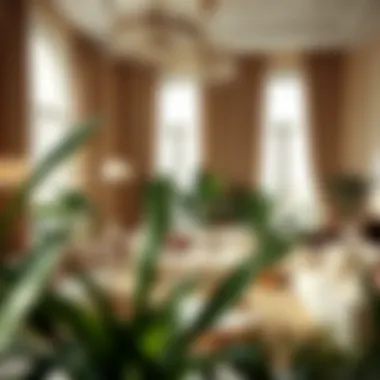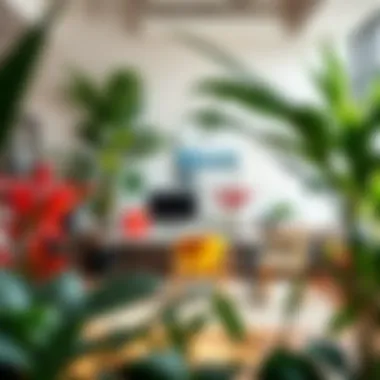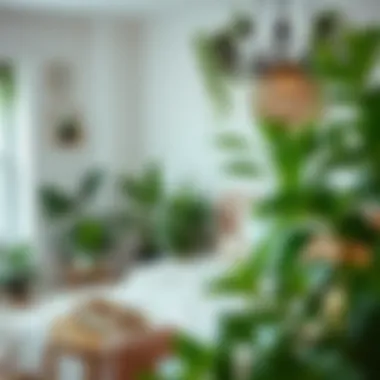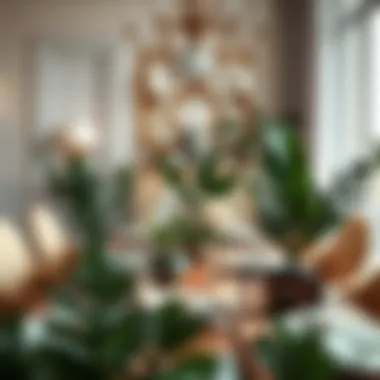The Elegance of Great Fake Plants in Home Decor


Intro
In recent years, the realm of interior decoration has seen a shift, with artificial plants stepping into the spotlight. While real plants have their undeniable charm, the elegance and practicality of fake plants are changing how we perceive greenery in our homes. Gone are the days when fake plants were viewed as a poor substitute. Today, they symbolize a blend of aesthetics and ease, serving as sophisticated accents in modern decor.
The Role of Fake Plants in Home Decor
Fake plants can effortlessly elevate a space without the maintenance hassle that comes with living flora. They offer the ability to introduce color, texture, and a hint of nature, contributing to a serene environment. This article aims to dissect how to choose quality artificial plants, maximize their visual impact, and integrate them across various living spaces.
By understanding the nuances of incorporating these elements into your home decor, you will find that artificial plants can foster a refined atmosphere while maintaining style and functionality.
Let’s explore two key aspects that frame this conversation: the current trends in furniture design and practical tips for furniture selection that can harmonize beautifully with your choice of fake plants.
Understanding the Appeal of Fake Plants
In the world of interior design, the inclusion of flora can significantly elevate the ambiance of a space. However, not everyone possesses a green thumb or the time required to nurture live plants. This is where fake plants come into play, presenting an alternative that is both stylish and practical. Understanding their appeal encompasses various elements that cater to modern lifestyles while maintaining an aesthetically pleasing environment.
Defining Artificial Botanicals
Artificial botanicals, commonly known as fake plants, are crafted from materials that replicate the appearance of real flora. These can range from plastic to silk, depending on the quality and intended use. Unlike their living counterparts, fake plants need no watering, sunlight, or special care, yet they can provide the similar visual benefits of greenery without the associated responsibilities. They are often meticulously designed to mimic the details found in nature, from the texture of leaves to the vibrancy of colors.
Benefits of Incorporating Faux Flora
Low Maintenance Requirements
One of the striking features of faux flora is their remarkable low maintenance requirements. Homeowners and decorators alike appreciate that these plants do not necessitate watering, pruning, or repotting. This aspect is especially appealing for busy individuals or those who may not have the conditions conducive to plant care, such as inadequate sunlight. The convenience of placement without the worry of plant health makes it a sought-after choice in today’s fast-paced living environments.
Long-Term Cost Efficiency
When considering the long-term implications of decor choices, the cost efficiency of fake plants emerges as a prominent factor. While the upfront expense for high-quality artificial plants may be notable, they stand the test of time without the need for replacement as often as real plants, which may wither or require ongoing care. This longevity equates to significant savings over the years, making faux plants an attractive investment for those mindful of their budget.
Allergy-Friendly Options
For many, seasonal allergies can put a damper on the joy of decorating with real plants. Enter allergy-friendly options in the realm of artificial plants. These options eliminate the pollen burden associated with live plants, allowing everyone—including those with sensitivities—to enjoy the aesthetic benefits of greenery. This characteristic is key for creating a welcoming and inclusive atmosphere that is harmonious for all occupants of a space.
Versatile Placement Potential
The versatility of fake plants adds another layer of appeal in home decor. They can be strategically placed in diverse areas such as living rooms, kitchens, or even bathrooms, enhancing any space they occupy without the limitations that live plants impose. Their ability to complement various design themes—from contemporary to traditional—means that one can achieve a cohesive look throughout the home with ease.
"Faux plants allow you to bring a sense of nature indoors, without the frills of upkeep."
In summary, understanding the appeal of fake plants is not merely about aesthetics; it's a comprehensive assessment of practicality, sustainability, and design versatility. As home spaces evolve, so too does the appreciation for elements that blend beauty with functionality.
Distinguishing Quality in Fake Plants
When it comes to selecting artificial botanicals for home decor, quality can make a world of difference. Recognizing the characteristics that set apart high-end faux plants from their lesser counterparts is essential for maintaining an appealing aesthetic while ensuring durability and longevity. This section will cover the various aspects of material choice and craftsmanship that lead to remarkable fake plants.
Materials and Craftsmanship
Types of Materials Used
The materials employed in the construction of artificial plants significantly influence both their appearance and longevity. Common materials include:
- Plastic: Generally lightweight and cost-effective, plastic faux plants can mimic the shapes of real foliage quite adeptly. However, lower-quality plastics might look cheap and fade over time when exposed to sunlight.
- Silk: Often considered a hallmark of higher-quality faux plants, silk offers a soft texture that closely resembles natural leaves. It allows for detailed prints and vibrant colors, but silk can gather dust easily and may require more care.
- Latex: This material offers a more realistic feel compared to plastic and silk. One of its unique features is durability—latex plants are less prone to discoloration and tearing, making them a preferred choice for those desiring longevity.
In essence, high-quality materials contribute not only to the appearance but also to the overall strength of the plant. The intrinsic appeal of these materials is evident when integrated into any space, providing a touch of elegance that is hard to overlook.
Assessment of Realism in Design
Evaluating the realism of artificial plants is another crucial aspect. Quality fake plants often feature intricate details that mimic nature, such as varying leaf sizes and imperfect symmetry. Key elements include:
- Color Variations: Authentic plants boast an array of hues, and a proficiently crafted faux plant incorporates subtle color changes to reflect that.
- Texture: Realistic faux plants tend to offer diverse textures, making them visually engaging. The uneven surfaces of leaves or branches can greatly add to the plant's authenticity.
- Shape and Structure: The way a plant is arranged—whether it appears lush and full or sparse—can impact realism. Quality craftsmanship will account for how plants grow and maintain their shapes in nature.


The fashioning of these elements is what brings a synthetic plant closer to its living counterpart, reshaping the perspective on artificial botanicals from mere decor to lifelike enhancements in the home.
Evaluating Durability and Longevity
Signs of Quality Construction
Durability is a cornerstone for determining quality when it comes to fake plants. Recognizing signs of well-made products will guide consumers to choices that stand the test of time. Some indicators include:
- Solid Base: Quality fake plants typically feature weighted bases that prevent them from tipping over easily.
- Secure Connections: Inspecting the joints and branches for solid assembly can reveal the care taken during creation. Weak seams may signal a product likely to fall apart sooner than expected.
- Resilient Leaves: High-quality leaves often don’t bend or break when handled, showcasing a robust construction that can endure occasional rearranging or dusting.
Arriving at these conclusions could bolster one's confidence in making a wise investment in home decor.
Manufacturer Reputation
A manufacturer’s standing can heavily influence the quality of artificial plants they offer. Reputable companies often have the experience and resources to produce superior products. Considerations include:
- Consumer Feedback: Reviews and ratings can provide insight into the performance of plants over time.
- Return Policies: Brands that stand behind their products with generous return policies often prioritize customer satisfaction, indicating a commitment to quality.
- Warranty Offerings: A manufacturer that provides extended warranties signals confidence in the durability of their product.
By navigating through the reputation of brands, buyers are better equipped to discern which plants can complement their home decor in a stylish yet sustainable manner.
Creative Placement Strategies
In the world of interior design, how you place items can be the difference between an ordinary home and a stunningly elegant one. Creative placement strategies for artificial plants not only elevate aesthetics but also enhance the atmosphere of various spaces within a home. Thoughtful design choices in plant positioning can lead to a harmonious and inviting environment that feels alive, despite the lack of natural growth.
Incorporating Fake Plants in Different Rooms
Living Room Aesthetics
The living room is often the heart of a home, a space where family gathers and friends converge. When artificial plants are introduced here, they serve to soften the hard lines of furniture and decor, creating a warm and inviting atmosphere. One popular choice is to place a tall faux fiddle leaf fig near a window or at the edge of a statement chair—this draws the eye up and adds a touch of nature without overwhelming the space.
- The natural shape and size of plants like this create a visually appealing focal point.
- It’s a well-loved option for many as it invites life into what can be a very static display of furniture.
On the flip side, while they can fit many aesthetics, not all plants blend seamlessly. Choosing the wrong type of plant—say, one that’s too small or not matching the room’s overall vibe—might detract from rather than enhance the living room’s character.
Bedroom Serenity
In the realm of tranquil spaces, bedrooms are meant for relaxation. Integrating artificial plants can contribute significantly to this goal. For instance, a delicate cluster of faux succulents on a bedside table or a single lush fern in a corner can promote feelings of calmness.
- Visual softness of plants can create a sense of tranquility, soothing a busy mind.
- Their styles can span from minimalist to lush jungles, allowing for personal expression.
However, it's crucial to balance. Too many plants or an overly cluttered look may interfere with the serene space one desires. The trick lies in selecting a couple of quality pieces rather than overcrowding the area.
Office Spaces
Office environments tend to be trickier as they often are designed for productivity and focus. Incorporating artificial plants here can introduce a breath of fresh air. A classy snake plant on a desk or a group of small potted plants on shelving could greatly enhance the visual appeal of the workspace.
- These additions not only serve as decoration but may also help in reducing stress and improving morale.
- Employees often find that even the presence of green additions can boost creativity and focus.
Yet, while faux greenery can lessen the monotony of office décor, it's wise not to go overboard, as excessive decor can become distracting. Keeping the arrangement simple and intentional can foster a productive atmosphere.
Bathrooms Enhancements
Bathrooms often get overlooked when it comes to decor, yet they can benefit immensely from the addition of artificial plants. A small pot of faux lavender on the vanity or hanging plants made of silk can create a spa-like ambiance, turning a routine into a mini-retreat.
- These plants contribute freshness in otherwise sterile spaces, making them feel more lively and inviting.
- The humidity in bathrooms can be harsh on real plants, so artificial options are ideal here.
However, one must be cautious with placement. An overabundance of plants can cause a cramped feeling, so picking one or two pieces that draw attention without crowding is essential for bathroom decor.
Mixing Real and Faux Plants
Creating a Cohesive Look
Blending real and artificial plants can yield an aesthetically pleasing and cohesive look, enhancing the overall ambiance of a home. The key characteristic here is harmony—ensuring the colors and textures work well together. This strategy allows for a much broader palette of design choices.


- Plants can be arranged in such a way that the lines between real and faux become blurred, creating continuity in design.
- It encourages a journey through the space, drawing the eyes across various designs and textures.
However, it’s worth noting that integrating real and faux requires a keen eye. It’s easy to end up with an arrangement that feels confused or mismatched if care isn’t taken to maintain a consistent theme throughout.
Balancing Texture and Color
When it comes to creating a balanced atmosphere, texture and color play pivotal roles. Varied textures from different plant types can bring depth to any arrangement. Utilizing a mix of silky leafed artificial plants alongside rugged-looking real ones can create a vibrant contrast that’s pleasing to the eye.
- Choosing plants with complementary color schemes — perhaps lush greens supplemented with soft pinks or deep reds — brings out the character of both real and fake plants.
- This balancing act not only maintains a fresh look but also allows personal expression through nature.
Yet finding that perfect balance can be tricky. Overly contrasting colors or clashing textures can lead to disarray in an otherwise composed design. The challenge lies in selecting pieces that resonate well together.
Maintenance and Care of Artificial Plants
When it comes to placing artificial plants in your home, regular maintenance and care play a significant role in keeping them looking splendid. Thoughtful attention to these faux flora not only enhances their aesthetic appeal, but also prolongs their lifespan, ensuring that your home decor looks fresh for longer periods. The core idea here is that even though these plants don’t require the nurturing a real plant does, neglecting them still can lead to their charm fading over time. After all, a dusty, faded plant stands out like a sore thumb, detracting from the overall elegance of your interior design.
Cleaning Techniques
Frequency of Cleaning
One might just think, "How often can I disregard cleaning those fake plants?" However, the frequency of cleaning plays a crucial role in maintaining their day-to-day vibrancy. Ideally, it would be best to wipe down your artificial plants every couple of months, more often if they are placed in high-traffic areas or near sources of dust and dirt. This seemingly simple act ensures that you retain the full beauty of the foliage without those pesky dust bunnies bogging down their visual appeal.
Not only does regular cleaning help to keep the plants looking spick and span, but it also prevents a full-blown cleaning chore down the road. Nobody wants to spend an entire afternoon scrubbing layers of dust; a quick dust-off now and then is a smart move that pays off.
Appropriate Cleaning Materials
Now, as for cleaning supplies, it’s crucial to choose appropriate materials. Using a microfiber cloth is often a popular choice; it’s gentle and won't scratch the surface of your faux leaves while effectively capturing dust. Avoid using harsh chemicals or abrasive sponges, as these can damage the finish or even cause colors to fade, rendering your elegant displays less attractive.
Water mixed with a mild soap can work wonders too! Just remember to dampen the cloth, not soak it, because too much moisture can be a bad idea—nobody wants a soggy plant. The right cleaning tools can make the difference between a dusty eyesore and a stunning centerpiece.
Preservation of Color and Texture
UV Protection
One of the more underrated aspects of maintaining artificial plants is considering UV protection. Direct sunlight can easily lead to colors fading, turning vibrant greens into dull pastels over time. Many contemporary faux plants come with built-in UV protection, making them an excellent choice for bright spaces.
By investing in UV-protected plants, you are committing to a longer-lasting decor element. It’s akin to covering your furniture with a nice fabric to shield it from wear and tear—prevention is always better than cure. However, if your plants aren't UV resistant, consider placing them in areas that won’t see too much sun exposure to keep those colors intact for as long as possible.
Managing Dust Buildup
Dust—it's the enemy of home decor, especially when it comes to artificial plants. It not only hides the beauty of your decor but can lead to a grimy, shabby look. Managing dust buildup involves creating a systematic cleaning approach. Regular touch-ups as mentioned before will keep them free of dust and looking legit. When dust accumulates, it becomes more challenging to clean; think of it like letting the laundry pile up for weeks—ugh!
One nifty tip is to cover your fake plants with a breathable fabric when not on display to keep dust off. It can act as a shield and save you the trouble of frequent cleanups. But don't forget that dusting them every so often is like checking in on a friend; a little effort goes a long way in maintaining both beauty and friendship.
Trends in Artificial Plant Decor
Exploring the trends in artificial plant decor offers a clear view into the evolving preferences of homeowners and interior designers alike. As living spaces become increasingly multifunctional, the demand for aesthetic yet practical solutions intensifies. Fake plants serve not only as decorative elements but also as reflections of personal style and contemporary trends. This section discusses current aesthetics and future directions that provide innovative options and cater to varied tastes.
Current Aesthetic Trends
Minimalism in Home Design
Minimalism is like a breath of fresh air in the cluttered world of decor. This design philosophy emphasizes simplicity and the elimination of excess, allowing each piece, including artificial plants, to shine in its own right. Fake plants fit beautifully within minimalist setups as they offer a touch of nature without overwhelming the space.
The key characteristic of minimalism is its ability to create a tranquil atmosphere, which can lead to increased focus and reduced stress levels. The unique feature of incorporating fake plants into this design style is their zero maintenance requirement, meaning they can be enjoyed without the burden of care.
Advantages include:
- Consistency: Always lush and vibrant.
- Simplicity: Easy to match with understated furniture and decor.
Yet, one must be cautious; too many faux greens can disrupt the minimalist vibe and feel contrived. It’s essential to select fewer, higher-quality pieces that contribute meaningfully to the overall aesthetic.


Bold Plant Styles
On the flip side, bold plant styles have gained traction among those who want to make a statement. Think large, artistic faux plants strategically placed to capture attention. Their striking visual appeal can transform a mundane corner into a focal point, emphasizing individual taste and creativity.
The charm of bold plant styles lies in their ability to act as conversation starters. A singular oversized monstera or a towering fiddle leaf fig can punctuate a room’s design narrative, drawing the eye and evoking intrigue.
Benefits include:
- Dramatic Impact: Instantly elevates the space.
- Versatile Styles: Can fit into various decor themes, from eclectic to modern.
However, one drawback is the potential for overcrowding a space, making careful placement essential to avoid a jarring visual experience.
Future Directions in Faux Flora
Sustainable Sourcing of Materials
The conversation around sustainability in decor has grown louder, and fake plants are no exception. As homeowners become more conscious of their environmental footprint, there is a burgeoning demand for faux flora made from sustainable materials.
Key characteristics include:
- Ethical Production: Many companies are now embracing eco-friendly practices in their manufacturing processes.
- Longer Lifespan: A well-sourced faux plant can be more durable, reducing waste over time.
The unique feature of sustainable fake plants often involves the use of recyclable and biodegradable materials. This trend not only enhances decor but also aligns with broader environmental goals, making a beneficial choice for their charm and eco-conscious impact.
Customization and Personalization Options
In today’s consumer-driven market, personalization is king. Customization in fake plants allows homeowners to create unique pieces that perfectly fit their living spaces. Imagine having a tailored bonsai that brings your vision to life!
The essential characteristic of this trend is its capacity to resonate with individual styles, enabling décor that reflects personal stories and preferences. From specific pot selections to customized plant types, choices are virtually limitless.
Advantages of this personalization include:
- Unique Statement: No two spaces need to feel the same.
- Connection: A tailored piece can evoke memories or represent personal journeys.
Nevertheless, customization could sometimes lead to higher costs and longer wait times, which may be a consideration for those looking for quick solutions.
Impact on Home Environment
The integration of artificial plants into a home’s decor goes beyond mere aesthetics. These elements add substance to the environment, sculpting a space that resonates with peace and vibrancy. Understanding the psychological and spatial dynamics introduced by fake plants plays a crucial role in the overall design approach. People frequently spend countless hours meticulously arranging their living spaces, yet often overlook the influence of greenery.
Psychological Benefits
Influence on Mood and Well-Being
Fake plants can positively shift one’s mood. The presence of greenery, even if it’s artificial, evokes tranquility and eases stress. Numerous studies suggest that merely viewing plants can trigger a sense of calm and improved mental clarity. This is not just a whimsical notion; the human mind is naturally inclined towards nature, a concept known well in design philosophy. As such, incorporating faux flora can be a popular choice for those who wish to create a sanctuary at home.
The unique feature of these arrangements is their consistency. Unlike real plants, which require nurturing and tending, fake plants provide an everlasting presence of that serene essence without the worry of wilting or needing care. This reliability contributes significantly to the overall well-being, making it a wise option for many.
Aesthetic Comfort
The visual appeal of artificial plants directly ties into the aesthetic comfort they provide. Bright greens and lush textures create a welcoming haven. This is particularly important in spaces like living rooms or bedrooms, where comfort should reign supreme. A well-placed faux plant can soften sharp corners and add warmth, contributing to a cozy ambiance.
Moreover, the beauty of aesthetic comfort lies in its versatility. Many styles of faux plants can align seamlessly with diverse design trends, from minimalist to bohemian. This broad applicability renders them quite an advantage, allowing homeowners and designers to curate spaces that feel inviting yet polished.
Spatial Dynamics and Visual Effects
Enhancing Space Perception
When assessing the impact of fake plants, it's important to recognize their spatial dynamics, particularly in how they shape perceptions of space. By strategically placing artificial plants at varying heights and locations, a room can appear larger and more dynamic. The clever use of greenery can draw the eye upward, an aspect that significantly influences how one experiences a room.
The crux of enhancing space perception lies in layering. Verticality, achieved by utilizing tall faux plants, helps in breaking the monotony of horizontal lines found in furniture and fixtures. This aspect can make any space feel more inviting and open, a key benefit for those with limited square footage.
Making Use of Vertical Spaces
Vertical spaces often go neglected, leaving walls bare and uninspired. However, utilizing fake plants can dramatically transform these areas. By adding wall-mounted planters or hanging arrangements, designers can draw attention to these forgotten zones, creating a sense of height that enhances the overall atmosphere.
This method of decoration is particularly effective in smaller apartments or rooms where floor space is a premium commodity. The significant advantage here is the availability of diverse options in artificial plant designs, catering to various aesthetic preferences. Plus, the limited maintenance requirement of faux flora means that vertical trends can easily be sustained, making it a practical choice in the long run.
"Incorporating fake plants allows you to reap the benefits of nature's serenity without the upkeep."



